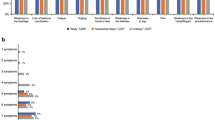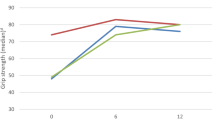Abstract
Introduction
Current guidelines for defining good outcomes in patients with chronic inflammatory demyelinating polyneuropathy (CIDP) are predominately defined by experts. At present, we do not have a patient-anchored definition of what constitutes a “good” outcome. Our study aimed to assess the symptom burden of people living with CIDP, as well as satisfaction with treatments and clinical outcomes.
Methods
We conducted an online-survey in CIDP patients registered with the US and Canadian GBS/CIDP foundations. Respondents answered general demographic and clinical questions, as well as satisfaction with current symptom burden and treatments, plus validated outcome measures.
Results
A total of 318 individuals with self-reported CIDP completed the online survey, of whom 128 (40%) considered their current disease burden as satisfactory while 190 (60%) did not. Of 305 patients who answered the treatment satisfaction question, 222(74%) were satisfied with their treatments. Patients who were satisfied with their current symptoms had, on average, better scores in quality of life and disease severity scales, although regression modeling showed that only ability to walk, stable symptoms, and health utility scores were associated with symptom satisfaction. Treatment satisfaction was associated with stable symptoms, use of IVIG, and use of one versus no medication.
Conclusions
A high proportion of members of the US and Canadian GBS/CIDP Foundations reporting a diagnosis of CIDP were unsatisfied with current symptoms, despite a high level of overall satisfaction with treatments. There is an unmet need for improving long-term outcomes in people with a diagnosis of CIDP, and for studying patient-centered long-term treatment goals.

Similar content being viewed by others
Data Availability
The datasets generated during and/or analyzed during the current study are available from the corresponding author on request.
References
Van Den Bergh PYK, Hadden RDM, Bouche P, Cornblath DR, Hahn A, Illa I, et al. European federation of neurological societies/peripheral nerve society guideline on management of chronic inflammatory demyelinating polyradiculoneuropathy: report of a joint task force of the European federation of neurological societies and the peripher. J Peripher Nerv Syst. 2010;15:1–9.
Allen JA, Gelinas DF, Lewis RA, Nowak RJ, Wolfe GI. Optimizing the use of outcome measures in chronic inflammatory demyelinating polyneuropathy. US Neurol. 2017;13:26–34.
Tubach F, Dougados M, Falissard B, Baron G, Logeart I, Ravaud P. Feeling good rather than feeling better matters more to patients. Arthritis Care Res. 2006;55:526–30.
Wijeysundera DN, Johnson SR. How much better is good enough?: Patient-reported outcomes, minimal clinically important differences, and patient acceptable symptom states in perioperative research. Anesthesiology. 2016;125:7–10. http://www.ncbi.nlm.nih.gov/pubmed/27159008
Myles PS, Myles DB, Galagher W, Boyd D, Chew C, MacDonald N, et al. Measuring acute postoperative pain using the visual analog scale: the minimal clinically important difference and patient acceptable symptom state. Br J Anaesth. 2017;118:424–9. https://doi.org/10.1093/bja/aew466.
Puyraimond-Zemmour D, Etcheto A, Fautrel B, Balanescu A, de Wit M, Heiberg T, et al. Associations between five important domains of health and the patient acceptable symptom state in rheumatoid arthritis and psoriatic arthritis: a cross-sectional study of 977 patients. Arthritis Care Res. 2017;69:1504–9.
Salaffi F, Carotti M, Gutierrez M, Di Carlo M, De Angelis R. Patient acceptable symptom state in self-report questionnaires and composite clinical disease index for assessing rheumatoid arthritis activity: identification of cut-off points for routine care. Biomed Res Int. 2015;2015:930756. https://doi.org/10.1155/2015/930756
Arnold MB, Khanna D, Denton CP, van Laar JM, Frech TM, Anderson ME, et al. Patient acceptable symptom state in scleroderma: results from the tocilizumab compared with placebo trial in active diffuse cutaneous systemic sclerosis. Rheumatology. 2018;57:152–7. https://academic.oup.com/rheumatology/article/57/1/152/4565530
Marks M, Hensler S, Wehrli M, Schindele S, Herren DB. Minimal important change and patient acceptable symptom state for patients after proximal interphalangeal joint arthroplasty. J Hand Surg (European Vol). 2018;175319341879956. https://doi.org/10.1177/1753193418799568
Queiro R, Brandy A, Rosado MC, Lorenzo A, Coto P, Carriles C, et al. Minimal disease activity and patient-acceptable symptom state in psoriatic arthritis: a real-world evidence study with ustekinumab. J Clin Rheumatol. 2018;24:381–4.
Daste C, Rannou F, Mouthon L, Sanchez K, Roren A, Tiffreau V, et al. Patient acceptable symptom state and minimal clinically important difference for patient-reported outcomes in systemic sclerosis: a secondary analysis of a randomized controlled trial comparing personalized physical therapy to usual care. Semin Arthritis Rheum. 2018. https://doi.org/10.1016/j.semarthrit.2018.03.013.
Tubach F, Ravaud P, Martin-Mola E, Awada H, Bellamy N, Bombardier C, et al. Minimum clinically important improvement and patient acceptable symptom state in pain and function in rheumatoid arthritis, ankylosing spondylitis, chronic back pain, hand osteoarthritis, and hip and knee osteoarthritis: results from a prospective multina. Arthritis Care Res. 2012;64:1699–707.
Mendoza M, Tran C, Bril V, Katzberg HD, Barnett C. Patient-acceptable symptom states in myasthenia gravis. Neurology. 2020;https://doi.org/10.1212/WNL.0000000000010574. http://www.ncbi.nlm.nih.gov/pubmed/32759200
Andersen LK, Jakobsson AS, Revsbech KL, Vissing J. Causes of symptom dissatisfaction in patients with generalized myasthenia gravis. J Neurol. 2021. https://doi.org/10.1007/s00415-021-10902-1.
Brooks R, De Charro F. EuroQol: the current state of play. Health Policy (New York). 1996;37:53–72.
Pickard AS, Law EH, Jiang R, Pullenayegum E, Shaw JW, Xie F, et al. United States valuation of EQ-5D-5L health states using an international protocol. Value Health. 2019;22:931–41. https://doi.org/10.1016/j.jval.2019.02.009.
Xie F, Pullenayegum E, Gaebel K, Bansback N, Bryan S, Ohinmaa A, et al. A time trade-off-derived value set of the EQ-5D-5L for Canada. Med Care. 2016;54:98–105. http://www.ncbi.nlm.nih.gov/pubmed/26492214
Brazier JE, Roberts J. The estimation of a preference-based index from the SF-12. Med Care. 2004;42:851–9.
Gwathmey KG, Conaway MR, Sadjadi R, Joshi A, Barnett C, Bril V, et al. Construction and validation of the chronic acquired polyneuropathy patient-reported index (CAP-PRI): a disease-specific, health-related quality-of-life instrument. Muscle Nerve. 2016;54:9–17.
van Nes SI, Vanhoutte EK, van Doorn PA, Hermans M, Bakkers M, Kuitwaard K, et al. Rasch-built Overall Disability Scale (R-ODS) for immune-mediated peripheral neuropathies. Neurology. 2011;76:337–45. https://doi.org/10.1212/WNL.0b013e318208824b.
Graham RC, Hughes RAC. A modified peripheral neuropathy scale: the overall neuropathy limitations scale. J Neurol Neurosurg Psychiatry. 2006;77:973–6.
Hughes R, Bensa S, Willison H, Van Den Bergh P, Comi G, Illa I, et al. Randomized controlled trial of intravenous immunoglobulin versus oral prednisolone in chronic inflammatory demyelinating polyradiculoneuropathy. Ann Neurol. 2001. https://doi.org/10.1002/ana.1088.
Terwee CB, Bot SDM, de Boer MR, van der Windt DAWM, Knol DL, Dekker J, et al. Quality criteria were proposed for measurement properties of health status questionnaires. J Clin Epidemiol. 2007;60:34–42.
Hanley JA, McNeil BJ. The meaning and use of the area under a receiver operating characteristic (ROC) curve. Radiology. 1982;143:29–36. http://www.ncbi.nlm.nih.gov/pubmed/7063747
Mielke O, Bril V, Cornblath DR, Lawo JP, van Geloven N, Hartung HP, et al. Restabilization treatment after intravenous immunoglobulin withdrawal in chronic inflammatory demyelinating polyneuropathy: results from the pre-randomization phase of the Polyneuropathy And Treatment with Hizentra study. J Peripher Nerv Syst. 2019;24:72–9.
Durand C, Eldoma M, Marshall DA, Bansback N, Hazlewood GS. Patient preferences for disease-modifying antirheumatic drug treatment in rheumatoid arthritis: a systematic review. J Rheumatol. 2020;47:175–87.
Allen JA, Gelinas DF, Freimer M, Runken MC, Wolfe GI. Immunoglobulin administration for the treatment of CIDP: IVIG or SCIG? J Neurol Sci. 2020;408: 116497. https://doi.org/10.1016/j.jns.2019.116497.
Overton PM, Shalet N, Somers F, Allen JA. Patient preferences for subcutaneous versus intravenous administration of treatment for chronic immune system disorders: a systematic review. Patient Prefer Adherence. 2021;15:811–34.
Allen JA, Butler L, Levine T, Haudrich A. A global survey of disease burden in patients who carry a diagnosis of chronic inflammatory demyelinating polyneuropathy. Adv Ther. 2021;38:316–28. https://doi.org/10.1007/s12325-020-01540-6.
Van den Bergh PYK, van Doorn PA, Hadden RDM, Avau B, Vankrunkelsven P, Allen JA, et al. European Academy of Neurology/Peripheral Nerve Society guideline on diagnosis and treatment of chronic inflammatory demyelinating polyradiculoneuropathy: report of a joint Task Force—Second revision. J Peripher Nerv Syst. 2021;26:242–68.
White D, Englezou C, Rajabally YA. Patient perceptions of outcome measures in chronic inflammatory demyelinating polyneuropathy: a study of the Inflammatory Rasch-built Overall Disability Scale. Eur J Neurol. 2021;28:2596–602.
Allen JA, Merkies ISJ, Lewis RA. Monitoring clinical course and treatment response in chronic inflammatory demyelinating polyneuropathy during routine care: a review of clinical and laboratory assessment measures. JAMA Neurol. 2020;77:1159–1166. https://jamanetwork.com/journals/jamaneurology/fullarticle/2764332
Kuwabara S, Mori M, Misawa S, Suzuki M, Nishiyama K, Mutoh T, et al. Intravenous immunoglobulin for maintenance treatment of chronic inflammatory demyelinating polyneuropathy: a multicentre, open-label, 52-week phase III trial. J Neurol Neurosurg Psychiatry. 2017;88:832–8.
Vanhoutte EK, Latov N, Deng C, Hanna K, Hughes RAC, Bril V, et al. Vigorimeter grip strength in CIDP: a responsive tool that rapidly measures the effect of IVIG—the ICE study. Eur J Neurol. 2013;20:748–55.
Kleyweg RP, Van Der Meché FGA, Schmitz PIM. Interobserver agreement in the assessment of muscle strength and functional abilities in Guillain-Barré syndrome. Muscle Nerve. 1991;14:1103–9.
Allen JA. The misdiagnosis of CIDP: a review. Neurol Ther. 2020;9:43–54. https://doi.org/10.1007/s40120-020-00184-6.
Koike H, Katsuno M. Pathophysiology of chronic inflammatory demyelinating polyneuropathy: insights into classification and therapeutic strategy. Neurol Ther. 2020. https://doi.org/10.1007/s40120-020-00190-8.
Lawley A, Abbas A, Seri S, Rajabally YA. Clinical correlates of fatigue in chronic inflammatory demyelinating polyneuropathy. Muscle Nerve. 2020. https://doi.org/10.1002/mus.26913.
Tran G, Dube B, Kingsbury SR, Tennant A, Conaghan PG, Hensor EMA. Investigating the patient acceptable symptom state cut-offs: longitudinal data from a community cohort using the shoulder pain and disability index. Rheumatol Int. 2020;40:599–605. https://doi.org/10.1007/s00296-019-04486-3.
Acknowledgements
We would like to thank the members of the GBS/CIDP Foundation in the US and Canada for their participation in this survey.
Medical Writing/Editorial Assistance
The authors did not use medical writing or editorial assistance for this article.
Funding
This study received funding from Grifols (Grant CLinician Initiated Research), through an investigator-initiated grant. The grant includes the journal’s Rapid Service Fee. The sponsor had no role in data collection, analyses or manuscript generation.
Author information
Authors and Affiliations
Contributions
Meg Mendoza: contributed to study design, data collection, data analysis, and manuscript preparation. Christopher Tran: contributed to study design and data collection. Hans D. Katzberg: contributed to patient recruitment for the pilot survey and critical review of manuscript. Vera Bril: contributed to patient recruitment for the pilot survey and critical review of manuscript. Carolina Barnett-Tapia: contributed to study design, data collection, data analysis, and manuscript preparation. Statistical analysis completed by Dr. Carolina Barnett-Tapia and Meg Mendoza.
Corresponding author
Ethics declarations
Conflict of Interest
Meg Mendoza reports no disclosures. Christopher Tran reports no disclosures. Hans D. Katzberg has been a consultant to Grifols, CSL Behring, UCB, Takeda (Shire), Alnylam, Octapharma, Akcea, Alexion, Pfizer, Biogen and Terumo: he has received research support from Takeda (Shire) and CSL Behring. Vera Bril has been a consultant to Grifols, CSL Behring, UCB, Argenx, Takeda (Shire), Alnylam, Octapharma, Powell Mansfield Inc., Akcea, Immunovant and Alexion; she has received research support from Grifols, CSL Behring, UCB, Argenx, Takeda (Shire), Octapharma, Baxalta and Biogen. Carolina Barnett-Tapia has been consultant to Alexion, Argenx, UCB and Sanofi; she has received grant support from Grifols and Octapharma. She is the developer of the MGII and may receive royalties.
Ethical Approval
This study was reviewed and approved by the University Health Network Research Ethics Board (Study number: 18-5514) and conforms to the World Medical Association Declaration of Helsinki. Participants of the pilot test provided written consent and answering the anonymous electronic survey was considered as implicit consent. We obtained written permission from the developers of the INCAT, RODS and CAPPRI to use the measures in this study. We obtained a license for the use of the SF-12 from QualityMetric, and we registered our study to use the EQ-5D-5L with EuroQoL (non-commercial, fast-track digital, no license needed).
Rights and permissions
Springer Nature or its licensor (e.g. a society or other partner) holds exclusive rights to this article under a publishing agreement with the author(s) or other rightsholder(s); author self-archiving of the accepted manuscript version of this article is solely governed by the terms of such publishing agreement and applicable law.
About this article
Cite this article
Mendoza, M., Tran, C., Bril, V. et al. Symptom and Treatment Satisfaction in Members of the US and Canadian GBS/CIDP Foundations with a Diagnosis of Chronic Inflammatory Demyelinating Polyneuropathy. Adv Ther 40, 5188–5203 (2023). https://doi.org/10.1007/s12325-023-02661-4
Received:
Accepted:
Published:
Issue Date:
DOI: https://doi.org/10.1007/s12325-023-02661-4




